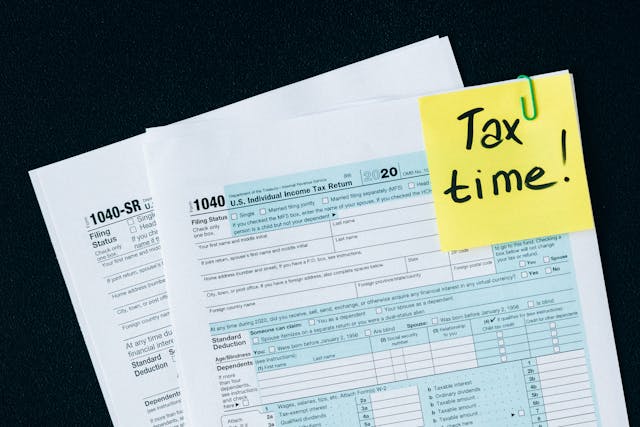With the IRS filing deadline just around the corner, many filers are wondering how much money they could see in their tax refund this year. Well, hang tight because we will break down some common scenarios and what you can expect based on your situation.
Crux of This Tax Return Loan Guide
- Owing taxes? File on time to avoid penalties.
- Need cash fast? Consider a Tax Return Loan.
- Estimating Your Refund? Use the IRS Withholding Calculator for an estimate.
- Taking Out a Tax Return Loan? Only borrow what you need to repay quickly.
- Watch out for fees if not paid off promptly.
Information in this blog could be helpful whether you’re looking to:
- Pay off debts,
- Save for a big purchase,
- Decide whether taking out a tax return loan makes sense while waiting for your return.
Note: Before diving in, remember that the April 18th, 2024 deadline to file your 2023 tax return is approaching. So, if you still need to file, we recommend you get your paperwork together soon to submit and get an estimate on what you may receive. The longer you wait, the longer it will take to get your refund. And if you end up owing, putting off filing will only result in penalties and interest charges added to your due balance.
 So, When Should You File?
So, When Should You File?
- April 18th, 2024, is the deadline, so make sure you do it by the middle of March.
- File as early as possible for the fastest refund.
- Also, late filing may result in penalties and interest.
Estimating Tax Refund Amounts Based on Filing Status:
Knowing what to expect from your tax refund can help determine if a tax return loan makes sense while you wait. Here are some common refund scenarios you might be in:
1. Single Filers without Dependents
- Income under $35k: Estimated Refund $500-$1000
- Income $35k-$50k: Estimated Refund $1000-$1500
- Income over $50k: Estimated Refund $500-$1000
On average, most single filers without dependents can expect to receive anywhere from $500-$1500 back, depending on their income and deductions claimed.
2. Married Filing Jointly
- Income under $50k: Estimated Refund $1000-$2000
- Income $50k-$75k: Estimated Refund $1500-$2500
- Income over $75k: Estimated Refund $1000-$2000
Married joint filers receive more refunds, around $1000-$2500.
3. Filers with Dependents
Add $200-$500 more to the above estimates if claiming:
- One child
- Two children
- Three+ children
How Filing Status Affects Refund Amounts
Filing status, whether single, head of household, married, filing jointly or separately, directly ties into both the standard deduction amount and tax bracket thresholds. The deduction lowers taxable income while brackets determine marginal tax rates applied. Joint filers receive a higher standard deduction versus single filers. Their combined income is also taxed at lower brackets than if filing separately.
For example,
Say Jessica earns $50,000 annually but files as single, putting her in the 22% tax bracket.
Compare this to Jessica and her husband, Jeff, who earns $25,000 annually and files jointly, which places them well within the much lower 12% bracket.
The resulting tax liability is substantially less when married filing jointly versus single, contributing to potentially more significant refund amounts.
Income Level Effects
How much one earns annually directly impacts withholding amounts and overall refund potential. The higher the income, the more taxes are typically withheld from paychecks across the year to cover liabilities. However, there is a “sweet spot” where refunds tend to be most significant for most filers.
For example,
Single filers without dependents generally see refunds average around $750-$1,500 if annual income falls between $25,000-$50,000.
Above $50,000, many are close enough in withholding that refund amounts start declining.
Earning under $25,000 might qualify one for beneficial credits but yield smaller refunds due to lower withholdings.
Other Variables that Affect Your Refund Size:
- More taxes withheld from paychecks = more considerable refund potential
- $3000 child tax credit per qualifying child under 17
- Retirement/Health Savings Account Contributions
- Student loan interest, medical costs, educator expenses, etc.
If you’re unsure about your potential refund amount, use the IRS Withholding Calculator to get a rough estimate of where you stand. Just be aware that these are only ballpark figures – your refund could come in higher or lower depending on your unique situation.
How Does the Refund Calculation Work?
- The IRS subtracts your total tax liability from the amount withheld from your paychecks and any estimated tax payments you made throughout the year.
- If you paid more than you owed, you will get a refund for the overpayment.
- Other standard deductions and credits include:
- Home mortgage interest/property taxes,
- Charitable donations,
- Medical/dental expenses,
- Classroom supplies for teachers,
- Energy rebates can lower your taxable income.
- Child Tax Credit (CTC) and the Earned Income Tax Credit (EITC) are tax deductions that can effectively reduce the tax debt owed by eligible taxpayers. The EITC is a credit for working individuals and families with low to moderate income. At the same time, the CTC is a credit for families with children. These deductions can be claimed on the individual’s tax return. It is important to note that eligibility for these credits depends on various factors, including income level, family size, and filing status. Therefore, take professional advice or consult the IRS guidelines before claiming these credits.
What is the Refund Receipt Timing
- Barring any issues requiring additional review, most e-filed returns result in refunds being issued within three weeks.
- Paper filers can track the status of their refund online or via the IRS2Go app but should expect to wait 6-8 weeks.
Some folks take out a tax return loan rather than wait 4-6 weeks for their refund to arrive if they need cash quickly for bills, a significant purchase, or other expenses. Just be sure only to borrow what you truly need and can afford to repay once your refund comes in. The fees associated with these loans can add up if not paid off promptly.
Caution: Relying on Rapid Refund Loans? Know That,
While they are convenient for instant cash, these products come with high fees that can cost filers much more than waiting for the standard refund delivery window. Only consider if truly necessary.
Additional Factors that Affect the Amount of a Tax Refund
Income level
Generally, the higher your income, the less refund you’ll receive as you’ll owe more taxes. However, there are also phaseouts of credits and deductions at higher income levels.
Changes in marital/dependent status
Getting married, divorced, having a new child, etc., can qualify you for different filing statuses and credits that impact refund amounts.
Deductions and credits claimed
Itemized deductions, education credits, health insurance exemptions, energy credits, and more can increase your refund amount.
Withholding allowances
Having the proper number of allowances adjusts how much is withheld from paychecks. Too many allowances could lead to owing taxes vs. a refund.
Side income or gig work earnings
Self-employment taxes and complicated returns take more effort to calculate proper withholding.
Investment and capital gains/losses
This impacts adjusted gross income and tax calculation in ways that can be more complex.
State tax filings
Many states base returns on federal AGI, so changes flow to state refund amounts.
IRS and state tax administration processing times
Backlogs or slow processing cause refund delays outside a filer’s usual timetable.
Audit/compliance interactions
Errors or audits trigger refund holds pending corrections or settlement of issues.
Actual Examples of Tax Refund Scenarios
Bringing the complex tax refund calculation to life, let’s look at some hypothetical but realistic examples using 2022 tax tables and credits:
- Steve, a single filer with one job as a restaurant manager earning $38,000, expects a refund of around $1,200 based on standard deduction and liability. He qualifies for a $500 saver’s credit for retirement contributions.
- Jessica and Frank filed jointly, have two kids under 6, and make $62,000, mainly from Frank’s construction work. Stimulus credits, child tax credits, and modest contributions slash their tax to $0, refunding the $4,500 withheld.
- Nancy is married and a teacher who earns $45,000. Her educator expenses of $750 and property taxes of $3,800 generate a $850 refund along with the standard deduction the joint filing provides.
- Brian is self-employed and earned $28,000 from his landscaping business in 2022. Paying $4,000 in estimated taxes with decent records returns $350 to him after itemizing deductions on Schedule C.
Bringing awareness to realistic scenarios helps connect the dots between personal financial situations and potential refund outcomes each tax season. By considering factors impacting their tax profile, filers can better determine strategies to maximize refunds when possible.
Conclusion – Tax Return Loan
Carefully reviewing one’s tax situation each year accounts for inevitable shifts influencing refund totals. Planning will help you to avoid surprises.
We hope this article gives you a better idea of what to expect for your tax return loan this year. Let us know if you have any other tax return loan or filing questions.
Please be advised that the information presented is intended only for informational purposes and should not be construed as financial advice. Please consult a tax, business, or finance professional for guidance on your unique situation before making any decisions.










